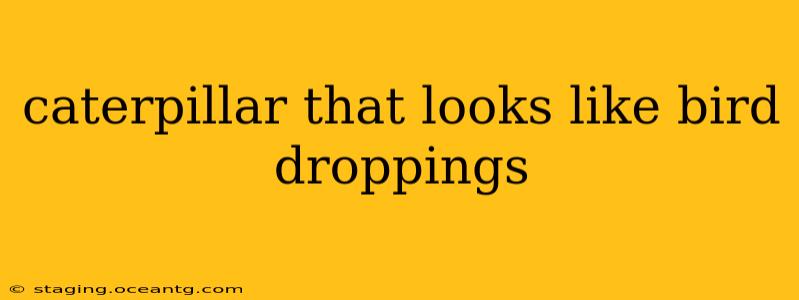Many caterpillars employ incredible camouflage to survive. One of the most fascinating examples is the caterpillar that cleverly mimics bird droppings. This ingenious disguise protects them from predators, allowing them to thrive in their environment. But which caterpillars pull off this amazing feat? Let's delve into the fascinating world of these masters of disguise.
What Kind of Caterpillar Looks Like Bird Droppings?
Several species of caterpillars exhibit this remarkable mimicry. Pinpointing a single "type" is difficult, as the resemblance isn't limited to a specific family or genus. Instead, it's a convergent evolution strategy – different species independently evolving similar characteristics to achieve the same protective benefit. However, some species are more commonly associated with this type of camouflage than others. You'll often find discussions online referencing specific species from the Sphingidae (hawk moth) and Geometridae (geometer moth) families, but visual confirmation is key, as many caterpillars can bear a superficial resemblance to bird droppings.
How Do These Caterpillars Mimic Bird Droppings?
The key to their disguise lies in their appearance and behavior. These caterpillars often exhibit:
- Coloration: Their bodies are typically speckled with shades of brown, black, and white, mirroring the varied colors and textures of bird droppings.
- Shape and Texture: Many possess a bumpy or lumpy texture that further enhances the illusion. Some even have a slightly elongated, tapered shape reminiscent of a bird dropping's form.
- Position: They frequently position themselves on leaves or branches in a way that reinforces the disguise. This positioning can sometimes be quite specific to the individual species.
Essentially, it's a sophisticated combination of coloration, shape, and strategic positioning that fools predators into believing they are nothing more than unappetizing bird waste.
What Are the Benefits of This Camouflage?
The primary benefit is protection from predators. Birds, lizards, and other insectivores are far less likely to attack something they perceive as waste. This camouflage significantly increases their chances of survival, allowing them to feed and grow without constantly being threatened.
Are All Caterpillars That Look Like Bird Droppings the Same Species?
No. As mentioned earlier, this type of mimicry is a convergent evolution strategy. Multiple unrelated species have independently evolved this form of disguise. It's a testament to the power of natural selection and the effectiveness of this protective mechanism. While they may look similar, they are often from different families and even orders of insects.
How Can I Identify a Bird Dropping Caterpillar?
Positive identification requires careful observation and potentially, expert consultation. Photographs can help, but a precise species identification often needs a professional entomologist’s input. Focusing on the caterpillar's specific markings, size, host plant, and location can provide clues. Remember, there are many caterpillars that resemble bird droppings but aren't exact matches.
Where Can I Find Caterpillars That Look Like Bird Droppings?
The locations where you'll find these caterpillars depend entirely on the specific species and its host plants. They're found worldwide in diverse habitats, wherever their host plants thrive. Your best bet for spotting them is to carefully examine leaves and branches of plants known to host caterpillars in your region.
This detailed response aims to provide comprehensive information while addressing potential reader queries organically. Remember to always approach wildlife with respect and observe them from a safe distance.
